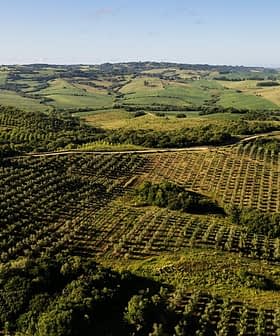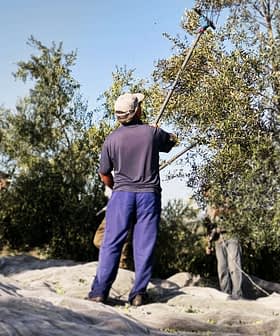It already speaks Chinese. Brazilian too. Our prized extra virgin olive oil has become an example of multilingual prowess. And only because its benefits are recognized by those inhabitants from other countries who, rather than dressing their salads or pairing it with their recipes, are interested in staying healthy.
Oriental and Brazilian palates just love this gastronomic gem and do not hesitate to link its origins to our country. At least this is the perception OLIVARAMA got after visiting the China International Olive Oil Exhibition 2013, in Guangzhou, and SIAL, in Brazil.
Spanish olive oil is currently sold in over 140 countries from all five continents. Its world-wide renown is on the increase and, in recent years, in emerging markets such as China and Brazil it has become far stronger. This is confirmed by various studies conducted by national bodies such as the Spanish International Chamber of Commerce (ICEX) or the Interprofesional del Aceite de Oliva Español, which show that this foodstuff is highly acclaimed by consumers in both countries, mainly, due to its quality.
This situation arises from an obsession with health that characterizes both the Chinese and the Brazilian people, who prioritize the multiple benefits it offers the body when acquiring this product.
According to the Chinese Customs Authorities, up until June the Asian country had bought 10,302 tonnes of Spanish oils, representing a growth of 27.50 percent compared to the same period the previous year, in 2012. For its part, Brazilian imports also grew by 18.84 percent, to 8,735 tonnes.
Clearly, Made in Spain is triumphing beyond our borders. Sales of our oil are more than just extraordinary. Spain is positioned among the main providers of liquid gold in the world and yet, this is still a great unknown among the majority of the country’s inhabitants.
This is why Olivarama, in its tour of various cities all over the world, made a stop in these countries this year in order to spread the word about the jewel of our gastronomy. Last June, we visited the China International Olive Oil Exhibition 2013, held in Guangzhou. At the end of the same month, we attended SIAL Brazil, in Sao Paulo.
More knowledge, more consumption
The International Olive Council (IOC) foresees that in the 2012/13 campaign, olive oil consumption may increase to around 10,000 tonnes in China (twentieth in the world ranking of olive oil consumption and seventh biggest olive oil importer in terms of volume); and 70,000 tonnes in Brazil (our second biggest client on the American continent and ninth world buyer of national oils).
Possibly the most effective tool for driving these figures is promotion. Promotional campaigns aimed at the end consumer that underline the versatility of this ingredient in the kitchen, it’s cultural roots, its link to tourism and, it goes without saying, its organoleptic properties which ultimately increase the number of fans to unsuspected heights.
This is something Olivarama knows all about, as wherever it goes it praises the Spanish harvests, or rather the extra virgins which are so lovingly produced by the national producers. And we did so in both of the aforementioned scenarios.
Of enormous international repute, both the Guangzhou event and that in Sao Paula project a very positive image of the future evolution of Mediterranean diet icon in their respective markets. This is precisely why Olivarama decided to get more deeply involved in both fairs with a view to fostering interest in our national juices among professionals and end consumers.
Two destinations, one sensorial pleasure
In China, middle-class inhabitants do not regularly use olive oil, except in specific cases, although they perceive it as a gourmet food, for cosmetic or even medicinal use. In this country, Spain’s position as the leading olive oil producer, the significant efforts made by companies and institutions of the sector to promote the product, and the dominant presence of olive oil on shelves have all contributed to strengthening the image of this sensorial pleasure.
According to the ICEX, the Asian giant probably constitutes the market with most potential for Spanish olive oil. So is Brazil which, with a population of 190 million inhabitants and a strong economic growth, has become one of the priority markets for Spanish olive oils.
In the Amazonian country, the changes registered in consumer tastes in recent years, as well as the increased purchasing power of the population, have boosted the purchase of this healthy foodstuff which has always been present in the Brazilian diet thanks to the Portuguese cultural influence.
Both of these territories clearly represent important commercial opportunities for the Spanish oil companies which, under threat from growing national competition, constitute “virgin” markets yet to be explored. Because we must remember that, for instance in China, in regions as proliferate as Gansu, Sichuan, Yunnan and Shaanxi they are already cultivating their own olive groves.
China
The incipient demand is mainly the result of an increased standard of living among its citizens, who prefer to acquire healthier foodstuffs as opposed to others that are more health harmful.
Although it is true that vegetable oils consumption is still significant, more and more consumers are introducing olive oil into their daily diet.
Their shopping is limited to large cities with a medium-high level of purchasing power and exquisite tastes, together with food habits with western influences.
In spite of the fact that its culinary uses are better understood, it is still largely unknown. In homes, this product is not used for direct consumption (salads), but rather it is perceived as a necessary ingredient for frying. The inhabitants of Beijing, Canton and Shanghai are the ones who prefer to season their dishes with it.
The majority of sales are registered in supermarket channels. It is also sold in the HORECA channel or gourmet shops.
Brazil
The decisive factor in Brazilian consumption habits is the high price and lack of knowledge about its culinary uses, as the majority only use it to dress salads, whereas very few use it to cook or fry, for example.
They buy mild oils, that tend to be sweeter, and prefer a greenish color as they associate it with quality.
The olive, virgin and extra virgin categories are usually bought. Use is limited, above all, to the Easter and Christmas periods to make typical cod dishes.
The middle class consumes most liters, specifically, athletes and those concerned about their health as they associate it with a healthy diet and lifestyle.
Geographically speaking, consumption is mainly concentrated in the southeast of the country, with the main centers being in Sao Paulo and Rio de Janeiro.
Source: ICEX









